Abstract
The pine wood nematode (Bursaphelenchus xylophilus, PWN) is a globally significant quarantine pest that causes severe economic and ecological damage to coniferous forests worldwide. Additionally, PWNs continue to expand into higher latitudes. However, studies on their cold tolerance remain limited. This study investigated the overwintering environment of PWNs in epidemic areas of Liaoning Province, China. It established a protocol to induce anhydrobiosis in PWNs, evaluated their low-temperature resistance, observed morphological changes during anhydrobiosis, and explored potentially involved key genes. The results showed that (1) there was no significant difference in thermal insulation between infected and healthy wood in Liaoning Province; both effectively reduced temperature fluctuation rates, providing a protective function for PWN overwintering. (2) PWNs significantly enabled their cold tolerance through anhydrobiosis, accompanied by significant morphological changes and substantial lipid droplet depletion. (3) Eleven anhydrobiosis-related genes were identified. Among these, the collagen gene family showed consistent expression patterns throughout dehydration and rehydration. This suggests a potential role in cuticle structural changes and osmoregulation during anhydrobiosis. These findings provide a theoretical basis for understanding how PWNs survive winter conditions in high-latitude regions. Additionally, they offer valuable insights for future research into PWN anhydrobiosis and the development of effective control strategies.
1. Introduction
Pine wilt disease is primarily caused by the pine wood nematode (Bursaphelenchus xylophilus), leading to considerable ecological and economic losses [1]. According to the National Forestry and Grassland Administration’s Document No. 5 of 2024, the pine wood nematode has now spread to the northeastern regions of China, where historical minimum temperatures have reached as low as −30 °C. PWNs show a trend of expansion toward higher latitudes. Previous studies suggest that the pine wood nematode has limited survival in subzero temperatures. Studies on their cold tolerance remain limited, particularly following their expansion into northern China.
Nematode cold tolerance strategies can be categorized into three types: (1) freezing tolerance, where nematodes can endure extracellular ice formation, with the lowest lethal temperature below the freezing point; (2) freeze avoidance, where nematodes prevent ice formation by lowering the supercooling point; and (3) protective dehydration, which significantly dehydrates the nematode’s body to avoid freezing. This dehydration strategy helps the nematodes avoid ice formation, enhancing their resistance to low temperatures [2,3,4].
Nematodes can enter cryptobiosis through dehydration, allowing them to survive extreme environmental stresses by temporarily halting their metabolism. Certain nematodes are capable of entering a cryptobiotic state by completely dehydrating, during which their metabolic activity is reversibly suspended. During dehydration, the organism gains resistance to various physical stresses, including extreme temperatures, high pressure, ultraviolet exposure, and radiation [5]. Nematodes are generally categorized into two major types based on their dehydration strategies: those that depend on gradual environmental water loss (slow-dehydration strategists) and those that actively regulate their own dehydration rate (fast-dehydration strategists). Through cryptobiosis, nematodes can survive extremely low temperatures. These nematodes undergo a gradual transition into cryptobiosis as they dehydrate. While in this state, their metabolism slows significantly and their life cycle is temporarily halted, but they can resume normal function upon rehydration in favorable conditions [6].
The cold tolerance of PWNs is influenced by many factors. Cold acclimation at 0 °C can enhance PWN cold tolerance [7]. Additionally, trehalose can promote the formation of DJ3 in PWNs, further improving their cold tolerance [8]. Cryptobiosis significantly increases the survival rate of PWNs at −20 °C and −80 °C [9]. The low-temperature response of PWN is associated with complex physiological and biochemical processes, such as trehalose metabolism [10], fatty acid metabolism [11], the cGMP pathway [12], and cytochrome P450 [13]. However, the mechanisms underlying cryptobiosis in PWNs and their extreme tolerance to −80 °C remain poorly understood, limiting the development of targeted strategies for cryopreservation or environmental adaptation control.
This study aims to identify the overwintering environments of pine wood nematodes in coniferous trees within the endemic areas of Liaoning Province to uncover the mechanisms by which cryptobiosis enables the cold tolerance of PWNs and to discuss the possibility of PWNs’ utilization of cryptobiosis for overwintering in cold regions. The findings will not only enhance our understanding of the nematodes’ ability to survive and spread in colder climates but also provide a theoretical foundation for the development of monitoring and early-warning strategies to mitigate their further expansion.
2. Materials and Methods
2.1. Nematode Strains and Cultures
All PWN-related procedures were performed in the Quarantine Laboratory of Beijing Key Laboratory for Forest Pest Control, Beijing Forestry University. The PWNs used in this experiment were a northern China strain isolated from infected wood in Liaoning Province, and a laboratory population was established in 2018. PWNs were cultured with Botrytis cinerea on barley medium at 25 °C in the dark. PWNs were cultured on barley medium in darkness at 25 °C, with Botrytis cinerea as their food source.
2.2. Investigation of Overwintering Temperatures of Pine Wood Nematodes in Liaoning Province
The experimental site was established in an artificial P. tabuliformis forest at the Dahuofang Experimental Forest Farm (41.9548° N, 124.2133° E). Trees showing a small number of yellowing needles in the canopy were identified as potentially infested. Wood samples approximately 8 cm in length were collected from each tree using an increment borer (Haglof), with at least three samples taken per tree. Nematodes were extracted from the samples using the Baermann funnel method and identified morphologically. Molecular identification was performed following the method described in Section 2.3 to verify the accuracy. Trees with confirmed PWN presence in the samples were classified as infested. Five infested and five healthy P. tabuliformis trees were selected, with a minimum spacing of 15 m between each tree. At a height of 1.5 m above the ground, a small hole approximately 8 cm deep and 1 cm in diameter was drilled. The probe of the temperature sensor (Vemsee vms-300C5, Jinan, China) was inserted into the hole, sealing holes with Vaseline. Five air temperature sensors were installed to monitor ambient temperature as an environmental group. Data from the sensors were set to be collected every 2 h from 1 November 2023–27 February 2024, which covers the entire winter. The temperature data were recorded using the mean ± standard deviation (SD).
2.3. Molecular Identification of Pine Wood Nematodes
DNA extraction from PWNs was performed using a modified proteinase K protocol. Individual PWNs were lysed in 8 μL ddH2O and 1 μL 10× Mg2⁺-free PCR buffer through rapid freezing in liquid nitrogen (1 min) followed by thermal shock (85 °C, 2 min). The lysate was then digested with 1 μL proteinase K (1 mg/mL) at 56 °C for 15 min, inactivated at 95 °C for 10 min, and directly used as a PCR template [14]. Amplification of the ribosomal 28S gene sequence was performed using specific primers (Bx28SD2A 5′-ACAAGTACCGTGAGGGAAAGTTG-3′ and Bx28SD3B 5′-TCGGAAGGAACCAGCTACTA-3′) [15] with DNA templates. PCR amplification was carried out under the following thermal cycling conditions: an initial denaturation at 94 °C for 4 min, followed by 35 cycles of 94 °C for 30 s, 55 °C for 30 s for primer annealing, and 72 °C for 1 min for extension. A final elongation step was performed at 72 °C for 10 min. PCR products showing distinct and single bands were submitted to Beijing Ruibo Xingke Biotechnology Co., Ltd. (Beijing, China) for sequencing, and the obtained sequences were compared against the B. xylophilus reference in the NCBI database.
2.4. Induction of Cryptobiosis and Pine Wood Nematode Survival
PWNs were placed into 1.5 mL centrifuge tubes and rinsed three times using a 1× PBS buffer solution. They were then treated with glycerol solutions at concentration gradients of 10%, 20%, 30%, and 40%, with each step lasting 20 min (dehydration stage). Once a significant reduction in nematode volume was observed, they were preserved at −80 °C for 24 h in 40% glycerol solution. Subsequently, they were rehydrated by transferring them to a 10% glycerol solution for 30 min, followed by 1× PBS buffer for another 30 min at 25 °C (rehydration stage). The survival rate of the PWNs was then calculated. Three biological replicates were performed, with approximately 100 nematodes in each group. PWNs without cryptobiosis procedures were subjected to the same low-temperature treatment as the control group. Survival rate data were recorded as mean ± standard deviation (SD).
2.5. Changes in Fat Content of Pine Wood Nematodes After Cryptobiosis and Cold Treatment Analysis
Cryptobiosis state monitoring and lipid quantification procedures in PWNs were observed and photographed using optical microscopy (ZEISS, Axiocam 208 color, Oberkochen, Germany) and stained with Oil Red O [16]. The proportion of the stained area relative to the total body area of the PWNs is referred to as the relative lipid droplet area (%). The relative lipid droplet area was quantified from micrographs using ImageJ (v1.53). Statistical comparisons were performed with Student’s t-test in GraphPad Prism (v9.0.0), with p < 0.05 considered significant.
2.6. RNA Extraction and Transcriptome Analysis
After treatment with the dehydration and rehydration stages, 30 μL samples of PWNs and untreated PMNs were collected and flash-frozen in liquid nitrogen, with five biological replicates prepared. Total RNA was extracted using the EASYSpin Plus Tissue/Cell RNA Kit (Aidlab, Beijing, China). RNA purification, reverse transcription, library preparation, and sequencing were carried out by Shanghai Majorbio Bio-Pharm Biotechnology Co., Ltd. (Shanghai, China), with sequencing performed on the DNBSEQ-T7 platform (MGI Tech Co., Shenzhen, China). The reference genome was obtained from NCBI (www.ncbi.nlm.nih.gov/assembly/GCA_904066235.2, accessed on 15 March 2025). The raw sequencing data from this study have been submitted to the China National GeneBank Sequence Archive (CNSA) with the project ID CNP0007008.
Gene expression levels were quantified in transcripts per million (TPM) using RSEM (v1.3.3). Differential expression analysis between groups was performed with the DESeq2 R package (v1.38), and the results were expressed as log2 fold change (log2FC) values. Gene expression quantification was performed with RSEM (v1.3.3) using transcripts per million (TPM) normalization. Differentially expressed genes (DEGs) between pairwise groups were identified through the DESeq2 R package (v1.38.0) with significance thresholds set at |log2(fold change)| > 1 and adjusted p-value < 0.05. Principal component analysis (PCA) was performed using the expression values (FPKM) to evaluate outlier samples and intergroup separation trends. Functional enrichment analysis of differentially expressed genes (DEGs) was conducted using the Gene Ontology (GO) database (http://www.geneontology.org, accessed on 15 June 2023) and the Kyoto Encyclopedia of Genes and Genomes (KEGG) pathway database (http://www.genome.jp/kegg/, accessed on 20 June 2023). A corrected p-value < 0.05 was considered statistically significant for the enrichment analysis.
2.7. qRT-PCR Analysis
To confirm the reliability of the transcriptomic results, quantitative reverse transcription PCR (qRT-PCR) was conducted on seven selected genes. Specific primers were designed using Primer3Plus (http://www.primer3plus.com/, accessed on 22 May 2025) and are listed in Table 1. qRT-PCR was carried out on a CFX96 Touch Real-Time PCR System (Bio-Rad, Hercules, CA, USA) utilizing SYBR Premix Ex Taq II (Takara, Dalian, China) in a total volume of 12.5 μL. Each reaction mixture consisted of 6.25 μL of SYBR Green master mix, 0.5 μL of each forward and reverse primer, 1.0 μL of cDNA, and 4.25 μL of nuclease-free water. The thermal cycling conditions were as follows: initial denaturation at 95 °C for 30 s, followed by 40 cycles of 95 °C for 5 s, 60 °C for 30 s, and 95 °C for 10 s. A melting curve analysis was subsequently performed from 65 °C to 95 °C, increasing by 0.5 °C every 5 s. Each sample was tested in triplicate, including three independent biological replicates. Relative gene expression was calculated using the 2−ΔΔCt method, with Actin-1 as the internal control. Data were recorded as mean ± standard deviation (SD).

Table 1.
Primers for qRT-PCR.
2.8. Phylogenetic Analysis of Nematode COL Gene Family
To investigate the evolutionary relationships of COL family members in B. xylophilus with those in other nematodes, multiple sequence alignment was performed using Geneious Prime (https://www.geneious.com (accessed on 22 May 2025), Version 2025.1). The collagen gene family, including 5 from B. xylophilus, 22 from C. elegans, 3 from C. briggsae, 2 from M. javanica, 1 from M. incognita, 1 from M. graminicola, 1 from D. destructor, 1 from A. besseyi, 1 from T. canis, 3 from G. pallida, and 2 from H. contortus, were used (Table A3). A maximum likelihood phylogenetic tree was then constructed based on the alignment results, using corrected Akaike information criterion (AICc) and Bayesian information criterion (BIC). The reliability of the phylogenetic tree was evaluated using MEGA12 with 1000 bootstrap replicates. The final visualization of the phylogenetic tree was performed using the iTOL online tool (https://itol.embl.de/, accessed on 22 May 2025). Data are presented as the mean ± standard deviation (SD), unless otherwise specified. Statistical analysis was performed using an unpaired two-tailed t-test for comparisons between two groups or one-way ANOVA for comparisons involving more than two conditions. A p-value of <0.05 was considered statistically significant.
3. Results
3.1. Internal Temperature Between the Healthy and PWN-Infested P. tabuliformis
The monthly average temperature did not differ significantly among the healthy, infested, and environmental groups. However, temperature fluctuations inside trees were significantly lower than those in the environment, with the monthly minimum temperature inside trees being approximately 4–5 °C higher than the environmental groups (Table 2).

Table 2.
Monthly temperature variation.
Temperature variation inside trees was stable on a diurnal timescale when the daily mean temperature inside trees was 0 °C, −10 °C, and −20 °C. The internal tree temperature decreased by 10 °C approximately every 21 days. The temperature changes for PWN overwintering inside trees were stable and gradual (Figure 1).
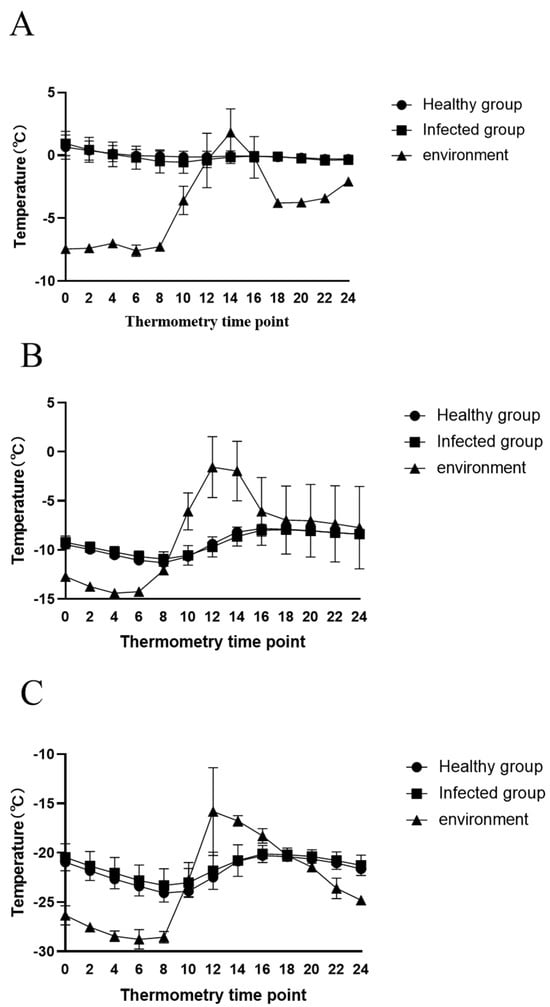
Figure 1.
Daily temperature variation: (A) 7 November 2023; (B) 1 December 2023; (C) 21 December 2023. Data are presented as mean ± SD (n = 5).
3.2. The Survival Rate of PWNs Following the Cryptobiosis Procedure Under Low-Temperature Conditions
Dehydrated PWNs were exposed to −20 °C, −40 °C, and −80 °C for 24 h, and their survival rates were recorded. The results showed that the survival rates of dehydrated PWNs at −20 °C, −40 °C, and −80 °C were 80.1%, 59.9%, and 48.13%, respectively. The hydrated PWNs were almost unable to survive under the same low-temperature treatment (Figure 2).
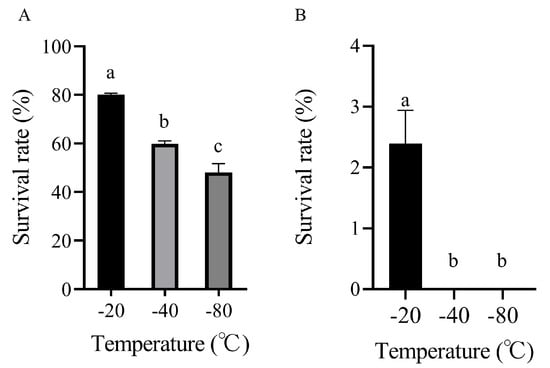
Figure 2.
Survival rate of dehydrated (A) and hydrated (B) PWNs at low temperatures. Data are presented as mean ± SD (n = 5). Different lowercase letters above the bars indicate significant differences between treatments (one-way ANOVA, Duncan’s multiple range test, p < 0.05), while the same letter indicates no significant difference.
3.3. Morphological and Fat Content Changes in Pine Wood Nematodes Under Cryptobiosis Treatment
Morphological changes in PWNs during the dehydration–rehydration cycle were continuously documented using optical microscopy. During the dehydration stage, as the glycerol solution concentration increased, PWN activity gradually declined, their volume significantly decreased, and noticeable body surface shrinkage was observed. After low-temperature treatment, during the rehydration phase, the nematodes gradually regained their volume, accompanied by a significant reduction in fat content. Discrete lipid droplets were observed, and the nematodes gradually regained their activity (Figure 3). Oil Red O staining produced distinct red staining, enabling clear visualization and identification of individual lipid droplets. Compared to the untreated PWNs, rehydrated PWNs showed a decrease in both the number and size of lipid droplets, especially the large, round droplets surrounding the intestine. Fat staining area data revealed that the fat content of rehydrated PWNs was significantly lower than untreated PWNs (p < 0.0001) (Figure 4).
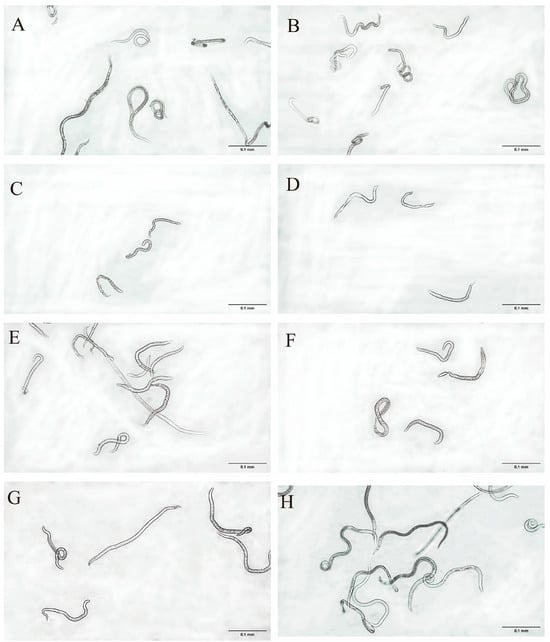
Figure 3.
Morphological changes of nematodes. (A) PWNs in 10% glycerol solution; (B) PWNs in 20% glycerol solution; (C) PWNs in 30% glycerol solution; (D) PWNs in 40% glycerol solution; (E) dehydrated PWNs after low-temperature treatment; (F) PWNs rehydrated in a 10% glycerol solution; (G) PWNs completely rehydrated in 1× PBS buffer; (H) untreated PWNs.
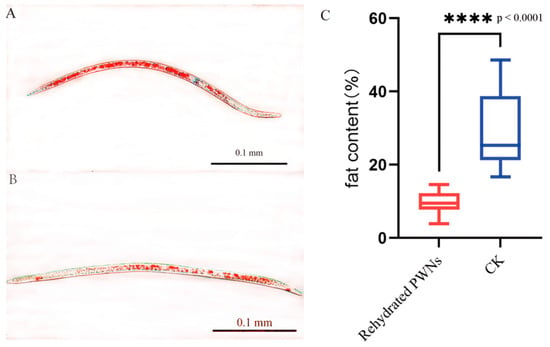
Figure 4.
Changes in the fat content of nematodes between rehydrated PWNs and CK (p < 0.0001). (A) Untreated PWNs; (B) rehydrated PWNs; (C) fat content.
3.4. Differential Gene Expression and Pathway Enrichment During Dehydration and Rehydration
Sequencing was performed using the DNBSEQ-T7 platform, generating 524.64 million raw reads from 12 samples across three groups: the dehydration group, the dehydration group, and the CK group. The average number of reads per sample was 43.72 million. After quality control, 519.01 million clean reads were retained, accounting for 99.85% of the raw data, with an average of 43.25 million clean reads per sample for subsequent assembly and analysis. The clean reads exhibited high average quality scores, with Q20 and Q30 values of 98.71% and 96.01%, respectively. The average GC content was 47.38%. Sliding window density analysis indicated that over 80% of the transcripts were uniquely mapped to the reference genome. Across the 12 samples, a total of 30.65 million clean reads were uniquely mapped, with an average mapping efficiency of 83.05% (Table A1). Clean reads were aligned to the reference genome to obtain mapped data, resulting in an average mapping efficiency of 86.60% (Table A2).
PCA analysis unveiled distinct patterns contingent upon both treatment groups, in which PC1 and PC2 explained 48.23% and 16.81%, respectively (Figure 5A). DEG analysis indicated that in the rehydration vs. CK group, the numbers of upregulated and downregulated genes were 862 and 1657, and in the dehydration vs. CK group, the numbers of upregulated and downregulated genes were 434 and 1062 (Figure 5B).
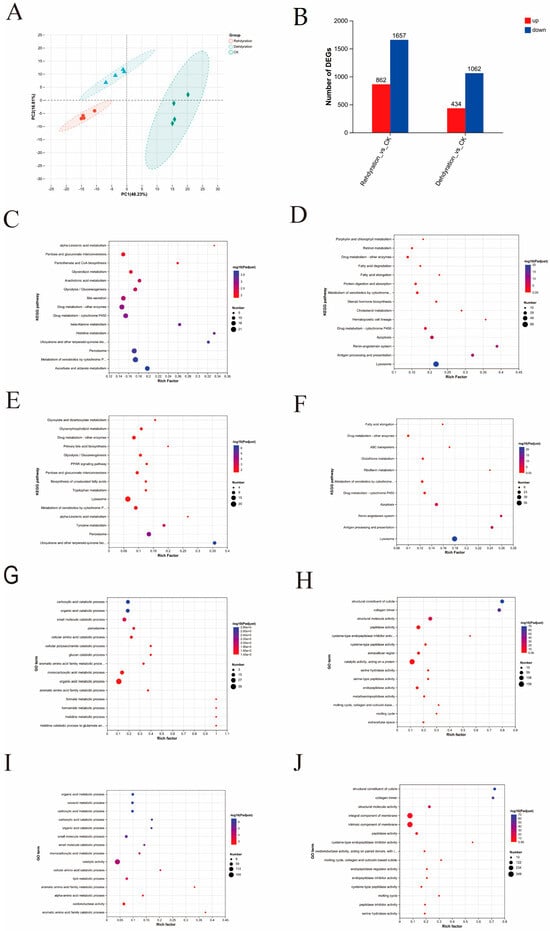
Figure 5.
Transcriptome analysis of the rehydration group, dehydration group, and CK group. (A) PCA analysis; (B) number of DEGs in each treatment group; (C) KEGG enrichment result for genes up-regulated in the rehydration group vs. the CK group; (D) KEGG enrichment result for genes down-regulated in the rehydration group vs. the CK group; (E) KEGG enrichment result for genes up-regulated in the dehydration group vs. the CK group; (F) KEGG enrichment result for genes down-regulated in the rehydration group vs. the CK group; (G) GO enrichment result for genes up-regulated in the rehydration group vs. the CK group; (H) GO enrichment result for genes down-regulated in the rehydration group vs. the CK group; (I) GO enrichment result for genes up-regulated in the dehydration group vs. the CK group; (J) GO enrichment result for genes down-regulated in the rehydration group vs. the CK group.
KEGG and GO enrichment analyses of differentially expressed genes (DEGs) revealed a dynamic metabolic reprogramming during the cryptobiosis-rehydration cycle. The enriched pathways in ascending order based on p-values. In the dehydration stage, the upregulated expressed genes are mainly involved in carbohydrate metabolism, lipid metabolism, and amino acid metabolism processes, such as the PPAR signaling pathway, pentose and glucuronate interconversions, biosynthesis of unsaturated fatty acids, tryptophan metabolism, and tyrosine metabolism. The downregulated expressed genes are mainly involved in xenobiotic biodegradation and metabolism, transport and catabolism, and membrane transport, such as lysosome metabolism of xenobiotics by cytochrome P450, riboflavin metabolism, and ABC transporters. In the rehydration stage, the upregulated genes are mainly involved in the digestive system and xenobiotic biodegradation and metabolism, such as bile secretion, drug metabolism—cytochrome P450, and drug metabolism—other enzymes. The downregulated expressed genes are enriched in the protein digestion and absorption and cholesterol metabolism pathways.
The top 15 pathways were identified from GO pathway enrichment analysis. The enriched pathways in ascending order based on p-values. DEGs were categorized into biological processes (BP), cellular components (CC), and molecular functions (MF). In the dehydration stage, the upregulated expressed genes are mainly involved in the aromatic amino acid family catabolic process, oxidoreductase activity, and alpha-amino acid metabolic process. The downregulated expressed genes are mainly involved in structural constituents of the cuticle, collagen trimers, and structural molecule activity. In the rehydration stage, the upregulated expressed genes are mainly involved in the formate metabolic process, formamide metabolic process, and histidine metabolic process. The downregulated expressed genes are mainly involved in structural constituents of cuticles, collagen trimers, and structural molecule activity. The downregulated genes in both the dehydration and rehydration stages were enriched in cuticle- and collagen-related pathways.
3.5. Identification and Expression Regulation Analysis of Key Genes
We selected 11 differentially expressed genes with clear functional annotations, including 5 collagen (COL), 2 venom allergen-like protein (VAP), 2 arginine kinase (AK), 1 cysteine proteinase inhibitor (CPI), and 1 cytochrome P450 (CYP). Among them, the COL gene family exhibited a consistent expression pattern (Figure 6). The expression of the COL gene family is significantly downregulated during both the dehydration and rehydration stages.
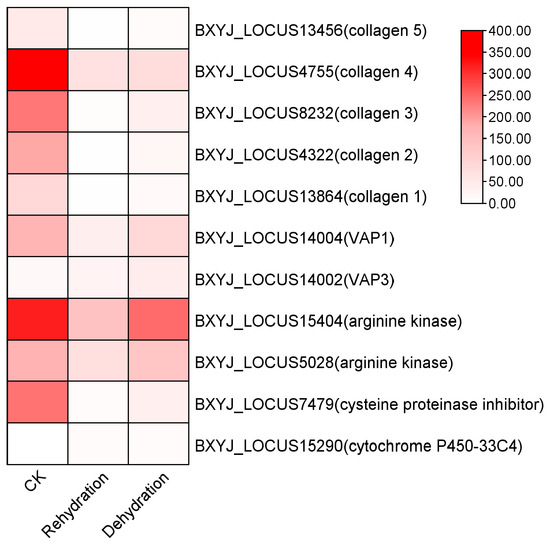
Figure 6.
Expression profiles of key genes.
3.6. qRT-PCR Validation
To validate the transcriptomic results, qRT-PCR was performed to analyze seven cryptobiosis-related genes in PWNs: BXYJ_LOCUS13864, BXYJ_LOCUS14004, BXYJ_LOCUS15404, BXYJ_LOCUS4755, BXYJ_LOCUS5028, BXYJ_LOCUS7479, and BXYJ_LOCUS8232. The qRT-PCR results were consistent with the gene expression patterns observed in the transcriptomic data, confirming the reliability of the transcriptomic findings (Figure 7).
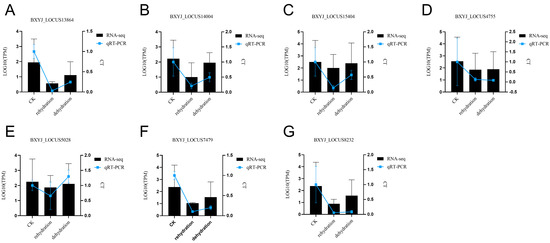
Figure 7.
qRT-PCR validation of candidate genes. (A) BXYJ_LOCUS13864; (B) BXYJ_LOCUS14004; (C) BXYJ_LOCUS15404; (D) BXYJ_LOCUS4755, (E) BXYJ_LOCUS5028; (F) BXYJ_LOCUS7479; (G) BXYJ_LOCUS8232. The qRT-PCR results are depicted as blue lines, while RNA-Seq data are represented by black columns. The y-axis on the left represents the normalized transcripts per million (TPM) obtained from RNA-Seq, while the y-axis on the right indicates the cycle threshold (CT) values measured by qRT-PCR. Data are presented as mean ± SD (n = 5).
3.7. Phylogenetic Analysis of the COL Gene Family
To investigate the phylogenetic relationships of the enriched PWN COL genes, we analyzed and compared the five enriched COL genes with 37 COL genes from other nematodes. The nematodes used for tree construction include three life forms: free-living nematodes, plant-parasitic nematodes, and parasitic nematodes. In addition, five collagen genes of B. xylophilus were annotated through BLAST alignment by Geneious Prime (https://www.geneious.com (accessed on 22 May 2025), Version 2025.1.1) [17]. An unrooted phylogenetic tree was constructed, revealing three major clades. BXYJ_LOCUS13864 (collagen1), BXYJ_LOCUS4322 (collagen2), and BXYJ_LOCUS13456 (collagen5) clustered within the same major branch.
BXYJ_LOCUS13864 (collagen1) and CAB02849.1 (C. elegans) were clustered within the same branch. BXYJ_LOCUS4322 (collagen2) and LC034171 (collagen-2, B. xylophilus) were also grouped in the same branch, while BXYJ_LOCUS13456 (collagen5) and CAA90084.1 (sqt-1, C. elegans) were located within another shared branch. BXYJ_LOCUS8232 (collagen3) and BXYJ_LOCUS4755 (collagen4) were located within the same major branch, clustering together in a sub-branch. LC034170 (collagen5, B. xylophilus) and CK582588.1 (C. elegans) were also clustered within the same sub-branch (Figure 8).
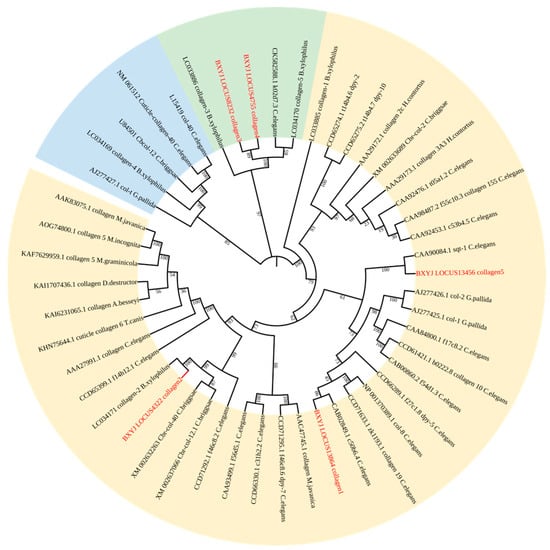
Figure 8.
Maximum-likelihood (ML) phylogenetic tree of the COL gene family in Bursaphelenchus xylophilus and other nematodes. Free-living nematodes: Caenorhabditis elegans; Caenorhabditis briggsae. Plant-parasitic nematodes: Meloidogyne javanica; Meloidogyne incognita; Meloidogyne graminicola; Ditylenchus destructor; Aphelenchoides besseyi; Globodera pallida. Parasitic nematode: Toxocara canis; Haemonchus contortus. The collagen genes of PWNs annotated in this study are highlighted in red font.
4. Discussion
PWNs overwinter inside infested pine trees, where internal tree temperatures are more stable than ambient air temperatures on both daily and monthly timescales. The tree serves as a natural cold acclimation environment, allowing PWNs to undergo prolonged acclimation at around 0 °C, thereby enhancing their cold tolerance. From the early stage of overwintering to the end of the following winter, the moisture content of the trees decreased from 39.36%–49.86% to 34.05%–41.03%. As temperatures dropped during the winter, the trees exhibited a negative water balance and an increase in solute concentration [18]. As pine wood nematodes (PWNs) overwinter inside the resin canals of coniferous trees, it is reasonable to assume that they undergo dehydration in parallel with the host tree’s water loss. Cryptobiosis is likely one of the overwintering strategies adopted by PWNs in cold regions. The overwintering ability of PWNs in cold regions may involve multiple cold tolerance strategies. Additionally, the procedures for cryptobiosis are straightforward, and the reagents used are simple, with a high survival rate. The current approach provides new opportunities for developing preservation methods for B. xylophilus strains.
At the extreme low temperature of −80 °C, the physiological activities of PWNs can be considered almost “paused”. The mechanism by which cryptobiosis enhances the cold tolerance of PWNs is likely primarily attributed to physiological and biochemical responses during the dehydration phase. Extensive water loss significantly reduces the formation of ice nuclei within the nematodes at low temperatures. Whether intracellular ice formation still occurs during the dehydration phase and how metabolic products contribute to inhibiting ice nucleation, maintaining cellular homeostasis, and preserving tissue integrity remain questions that require further investigation. In addition, whether PWNs produce cryoprotectants during their cryptobiotic state and the specific types involved remain to be further investigated. Previous studies have shown that nematodes can produce cryoprotectants in response to low-temperature exposure [19,20]. However, whether cryoprotectants are involved in the mechanism by which cryptobiosis enhances cold tolerance in PWNs remains to be further verified.
Trehalose and lipids play crucial roles in the cold tolerance of nematodes. Trehalose protects membrane structures during desiccation and stabilizes membranes against the adverse effects of fast rehydration [21]. Previous studies have shown that in the model nematode Caenorhabditis elegans, trehalose and triacylglycerols are consumed during the dehydration and rehydration process, leading to a reduction in dry weight, which is related to the upregulation of trehalose biosynthesis and gluconeogenesis. Furthermore, bdelloid rotifers can undergo anhydrobiosis without producing any trehalose [22,23,24,25]. For PWNs, trehalose is closely associated with DJ3 formation; DJ3 PWN can significantly enhance cold tolerance and resist low-temperature stress through cryptobiosis [9]. Additionally, compared to summer populations, winter PWN populations show significantly higher levels of trehalose and glycerol, while glucose levels decrease significantly. Changes in fatty acid composition and antifreeze levels, as physiological adaptations, play a crucial role in the successful overwintering of PWNs [26].
Contrary to canonical anhydrobiotic models (e.g., C. elegans), our RNA-seq data revealed no trehalose biosynthesis gene induction during the PWN dehydration–rehydration cycle, suggesting a new specific adaptation strategy. The decrease in fat content and the upregulation of lipid metabolism during the dehydration process in PWNs after cryptobiosis imply fatty acid catabolism dominated energy production in this phase. The surface lipids of nematodes are also closely related to osmoregulation, which can improve their ability to resist dehydration [27]. In addition, the breakdown of fats may also produce unsaturated fatty acids, which could increase the level of cryoprotectants in PWNs, thereby contributing to their cold tolerance. Based on current findings, we propose that the production of cryoprotectants and cryptobiosis represent two distinct cold tolerance strategies in PWNs. Meanwhile, it is possible that PWNs produce previously unidentified endogenous cryoprotectants during dehydration. Further investigation into the endogenous cryoprotectant profile of PWNs is necessary to more precisely elucidate the biochemical basis of their cold tolerance.
At lower solution concentrations, PWNs actively curl up to reduce contact with the solution and maintain some mobility. As the solution concentration increases, PWNs cease activity. During the dehydration and rehydration process, PWN volume negatively correlates with solution concentration, indicating that PWNs rely on osmotic regulation to adapt to desiccation stress. The downregulation of transport and catabolism and membrane transport during the dehydration stage and upregulation during the rehydration stage further support this hypothesis. Additionally, the downregulation of the structural constituent of the cuticle, the collagen trimer, and structural molecule activity during the dehydration and rehydration stages may be associated with changes in the PWN cuticle. These structural modifications likely enhance the nematode’s osmoregulatory capacity, allowing water to move freely in and out of the organism.
Collagen is a structural protein involved in the synthesis of the extracellular matrix in animals [28]. In nematodes, exemplified by C. elegans, collagen is involved in the formation of two distinct structures: the basement membrane and the cuticle [29]. The cuticle serves as a selective barrier in nutrient absorption and metabolite secretion [30], plays a crucial role as a counteracting structure for muscle movement, functioning as a skeleton [31], and provides excellent protection against adverse environmental conditions. In parasitic nematodes, it also plays a key role in defending against various host immune responses [32]. Collagen plays a crucial role in PWNs. Collagen is involved in the composition of the intestinal structure in PWNs. The intestinal structure of B. xylophilus differed between the mycetophagous and the phytophagous phases [33]. COL is significantly associated with the exogenous detoxification pathways in PWNs, with their expression levels being significantly upregulated under low concentrations of exogenous toxin treatment [34,35,36]. The epidermal growth factor, nematode cuticle collagen, and G-protein-coupled receptor genes with environmental adaptation functions were demonstrated to be differentially expressed under low temperatures. This enables the low-temperature tolerance of PWNs [37]. Additionally, PWNs’ collagen plays a role in interactions with their natural enemies [38].
Phylogenetic clustering of PWN COL genes with orthologs from 12 nematode species revealed strong functional conservation. Based on this comparison, the functions of PWN COL genes can be inferred. BXYJ_LOCUS13864 (collagen1) is likely involved in cuticle structure formation [39]. BXYJ_LOCUS4322 (collagen2), BXYJ_LOCUS8232 (collagen3), and BXYJ_LOCUS4755 (collagen4) have homologous genes that have been linked to cuticle morphological changes during the change in life history type (from mycetophagous to phytophagous phase), suggesting that they may all play roles in cuticle adaptation to environmental changes in PWNs [16]. BXYJ_LOCUS13456 (collagen5) is likely associated with body structure formation in PWNs [40].
COL gene downregulation post-rehydration may reflect cuticle structural relaxation to facilitate osmotic equilibrium, suggesting that these genes may play a key role in nematode osmoregulation. On one hand, COL genes are closely associated with the nematode’s cuticle, and their downregulation could indicate changes in the cuticular structure, making the nematode more susceptible to dehydration and rehydration. On the other hand, COL genes are involved in the composition of the intestinal structure, which may also be related to the reduction of lipid droplets near the intestine. The changes in the cuticle and intestinal structure during the PWN cryptobiosis process still need further validation.
5. Conclusions
PWNs overwinter within their host coniferous trees, where the average internal temperature is slightly higher than the ambient air temperature and exhibits significantly smaller daily and monthly fluctuations. This stability facilitates the cold acclimation of PWNs. Additionally, the increasing solute concentration of the host as temperatures drop creates conditions for PWN dehydration, allowing them to resist low temperatures through cryptobiosis. During the dehydration, PWNs break down lipid droplets, which may play a crucial role in osmotic regulation and contribute to the production of small-molecule cryoprotectants during cryptobiosis. The overwintering strategy of PWNs in cold regions is likely not singular but involves multiple adaptive mechanisms. PWNs rely on osmotic regulation during dehydration and rehydration. COL genes may play an important role in this process.
Author Contributions
Conceptualization, Y.L. and L.R.; data curation, Q.H., J.L. and L.R.; investigation, Q.H.; methodology, Q.H., J.L., L.C. and L.R.; resources, Q.H., J.L. and Y.L.; formal analysis, Q.H; supervision, Y.L. and L.R.; validation, Q.H.; writing—original draft, Q.H.; writing—review and editing, J.L., L.R. and Q.H.; project administration, Y.L. All authors have read and agreed to the published version of the manuscript.
Funding
Shandong Provincial Key Research and Development Plan (Major Innovation Engineering Program) 2024CXGC010911; National Key R&D Program of China (2021YFD1400900).
Data Availability Statement
The data has been uploaded to CNSA with the project number CNP0007008.
Acknowledgments
The authors would like to thank Lili Ren, Jiaxing Li, and Ling Cheng for their helpful suggestions and support during the research. We also thank Dahuofang Forest Farm in Liaoning Province for providing the Pinus tabuliformis forest research plot for our study.
Conflicts of Interest
The authors declare no conflict of interest.
Appendix A

Table A1.
The sequencing data summary table.
Table A1.
The sequencing data summary table.
| Sample | Raw Reads | Raw Bases | Clean Reads | Clean Bases | Error Rate (%) | Q20 (%) | Q30 (%) | GC Content (%) |
|---|---|---|---|---|---|---|---|---|
| CK1 | 42,366,036 | 6.4 × 109 | 42,000,684 | 6.3 × 109 | 0.0119 | 98.79 | 96.29 | 47.38 |
| CK2 | 42,327,428 | 6.39 × 109 | 41,895,908 | 6.28 × 109 | 0.012 | 98.71 | 96.03 | 47.41 |
| CK3 | 41,481,986 | 6.26 × 109 | 41,103,824 | 6.17 × 109 | 0.0119 | 98.78 | 96.22 | 47.39 |
| CK4 | 43,104,072 | 6.51 × 109 | 42,751,718 | 6.42 × 109 | 0.012 | 98.71 | 96.03 | 47.42 |
| Rehydration1 | 44,403,712 | 6.7 × 109 | 43,921,778 | 6.59 × 109 | 0.012 | 98.73 | 96.09 | 47.26 |
| Rehydration2 | 42,551,754 | 6.43 × 109 | 42,117,982 | 6.31 × 109 | 0.0119 | 98.78 | 96.24 | 47.09 |
| Rehydration3 | 40,757,948 | 6.15 × 109 | 40,331,136 | 6.05 × 109 | 0.0119 | 98.79 | 96.27 | 47.3 |
| Rehydration4 | 45,797,680 | 6.92 × 109 | 44,626,930 | 6.6 × 109 | 0.0127 | 98.33 | 94.88 | 47.27 |
| Dehydration1 | 42,028,322 | 6.35 × 109 | 41,613,696 | 6.26 × 109 | 0.0119 | 98.76 | 96.17 | 47.5 |
| Dehydration2 | 41,409,928 | 6.25 × 109 | 41,049,692 | 6.16 × 109 | 0.0121 | 98.68 | 95.91 | 47.47 |
| Dehydration3 | 48,823,610 | 7.37 × 109 | 48,412,074 | 7.26 × 109 | 0.012 | 98.69 | 95.98 | 47.49 |
| Dehydration4 | 49,590,206 | 7.49 × 109 | 49,189,402 | 7.34 × 109 | 0.012 | 98.71 | 96.02 | 47.52 |

Table A2.
The alignment result summary table.
Table A2.
The alignment result summary table.
| Sample | Total Reads | Total Mapped | Multiple Mapped | Uniquely Mapped |
|---|---|---|---|---|
| CK1 | 42,000,684 | 38,254,750 (91.08%) | 848,209 (2.02%) | 37,406,541 (89.06%) |
| CK2 | 41,895,908 | 38,231,385 (91.25%) | 790,980 (1.89%) | 37,440,405 (89.37%) |
| CK3 | 41,103,824 | 37,428,910 (91.06%) | 690,410 (1.68%) | 36,738,500 (89.38%) |
| CK4 | 42,751,718 | 38,381,943 (89.78%) | 802,785 (1.88%) | 37,579,158 (87.9%) |
| Rehydration1 | 43,921,778 | 39,244,377 (89.35%) | 875,453 (1.99%) | 38,368,924 (87.36%) |
| Rehydration2 | 42,117,982 | 37,320,080 (88.61%) | 752,388 (1.79%) | 36,567,692 (86.82%) |
| Rehydration3 | 40,331,136 | 36,077,967 (89.45%) | 775,102 (1.92%) | 35,302,865 (87.53%) |
| Rehydration4 | 44,626,930 | 39,020,139 (87.44%) | 849,493 (1.9%) | 38,170,646 (85.53%) |
| Dehydration1 | 41,613,696 | 37,499,060 (90.11%) | 797,006 (1.92%) | 36,702,054 (88.2%) |
| Dehydration2 | 41,049,692 | 36,955,748 (90.03%) | 944,981 (2.3%) | 36,010,767 (87.72%) |
| Dehydration3 | 48,412,074 | 39,154,428 (80.88%) | 1,473,524 (3.04%) | 37,680,904 (77.83%) |
| Dehydration4 | 49,189,402 | 42,819,615 (87.05%) | 2,239,725 (4.55%) | 40,579,890 (82.5%) |

Table A3.
Sequence accession number of the phylogenetic tree of the COL Gene Family.
Table A3.
Sequence accession number of the phylogenetic tree of the COL Gene Family.
| Species | Gene Name | Sequence Accession Number | Data Type | Source |
|---|---|---|---|---|
| C. elegans | col-40 | L15419.1 | Genomic DNA | NCBI Gene |
| B. xylophilus | col-1 | LC033885.1 | Genomic DNA | NCBI Gene |
| B. xylophilus | col-3 | LC033886.1 | Genomic DNA | NCBI Gene |
| B. xylophilus | col-4 | LC034169.1 | Genomic DNA | NCBI Gene |
| B. xylophilus | col-5 | LC034170.1 | Genomic DNA | NCBI Gene |
| B. xylophilus | col-2 | LC034171.1 | Genomic DNA | NCBI Gene |
| C. elegans | col-40 | NM_061512.5 | Transcript | NCBI Nucleotide |
| C. briggsae | col-12 | U84501.1 | Genomic DNA | NCBI Gene |
| C. briggsae | col-40 | XM_002632263.1 | Transcript | NCBI Nucleotide |
| C. briggsae | col-2 | XM_002633689.1 | Transcript | NCBI Nucleotide |
| C. briggsae | col-12.1 | XM_002637066.1 | Transcript | NCBI Nucleotide |
| C. elegans | col | AAA27991.1 | Protein | NCBI Protein |
| M. javanica | col | AAK83075.1 | Protein | NCBI Protein |
| M. incognita | col-5 | AOG74800.1 | Protein | NCBI Protein |
| M. graminicola | col-5 | KAF7629959.1 | Protein | NCBI Protein |
| D. destructor | col | KAI1707436.1 | Protein | NCBI Protein |
| A. besseyi | col | KAI6231065.1 | Protein | NCBI Protein |
| T. canis | cuticle-col-6 | KHN75644.1 | Protein | NCBI Protein |
| C. elegans | cuticle-col | CAB02849.1 | Protein | NCBI Protein |
| C. elegans | col-19 | CCD71633.1 | Protein | NCBI Protein |
| C. elegans | dpy-5 | CCD66289.1 | Protein | NCBI Protein |
| C. elegans | cuticle-col | CAB00860.2 | Protein | NCBI Protein |
| C. elegans | col-10 | CCD61421.1 | Protein | NCBI Protein |
| C. elegans | cuticle-col | CAA84800.1 | Protein | NCBI Protein |
| C. elegans | cDNA 5′ similar to K02D7.3 | CK582588.1 | Transcript | NCBI Nucleotide |
| C. elegans | cuticle-col | CCD65399.1 | Protein | NCBI Protein |
| C. elegans | cuticle-col | CAA92453.1 | Protein | NCBI Protein |
| C. elegans | col-155 | CAA98487.2 | Protein | NCBI Protein |
| C. elegans | cuticle-col | CAA93499.1 | Protein | NCBI Protein |
| C. elegans | dpy-7 | CCD71295.1 | Protein | NCBI Protein |
| C. elegans | dpy-10 | CCD65275.2 | Protein | NCBI Protein |
| C. elegans | dpy-2 | CCD65274.1 | Protein | NCBI Protein |
| C. elegans | cuticle-col | CCD66330.1 | Protein | NCBI Protein |
| M. javanica | col | AAC47745.1 | Protein | NCBI Protein |
| C. elegans | cuticle-col | CAA92476.1 | Protein | NCBI Protein |
| C. elegans | cuticle-col | CCD71292.1 | Transcript | NCBI Nucleotide |
| G. pallida | col-1 | AJ277425.1 | Protein | NCBI Protein |
| G. pallida | col-2 | AJ277426.1 | Protein | NCBI Protein |
| G. pallida | col-t | AJ277427.1 | Protein | NCBI Protein |
| C. elegans | col-8 | NP_001370389.1 | Protein | NCBI Protein |
| C. elegans | sqt-1 | CAA90084.1 | Protein | NCBI Protein |
| H. contortus | col-3A3 | AAA29173.1 | Protein | NCBI Protein |
| H. contortus | col-2C | AAA29172.1 | Protein | NCBI Protein |
References
- Futai, K. Pine Wood Nematode, Bursaphelenchus xylophilus. Annu. Rev. Phytopathol. 2013, 51, 61–83. [Google Scholar] [CrossRef] [PubMed]
- Wharton, D.A.; Goodall, G.; Marshall, C.J. Freezing survival and cryoprotective dehydration as cold tolerance mechanisms in the Antarctic nematode Panagrolaimus davidi. J. Exp. Biol. 2003, 206, 215–221. [Google Scholar] [CrossRef]
- Farman, A.; Wharton, D.A. Intracellular Freezing in the Infective Juveniles of Steinernema feltiae: An Entomopathogenic Nematode. PLoS ONE 2014, 9, e94179. [Google Scholar] [CrossRef]
- Naya, D.E.; Veloso, C.; Bozinovic, F. Physiological flexibility in the Andean lizard Liolaemus bellii: Seasonal changes in energy acquisition, storage and expenditure. J. Comp. Physiol. B Biochem. Syst. Environ. Physiol. 2008, 178, 1007. [Google Scholar] [CrossRef] [PubMed]
- Tunnacliffe, A.; Lapinski, J. Resurrecting Van Leeuwenhoek’s rotifers: A reappraisal of the role of disaccharides in anhydrobiosis. Philos. Trans. R. Soc. Lond. B Biol. Sci. 2003, 358, 1755–1771. [Google Scholar] [CrossRef]
- Gade, V.R.; Traikov, S.; Oertel, J.; Fahmy, K.; Kurzchalia, T.V. C. elegans possess a general program to enter cryptobiosis that allows dauer larvae to survive different kinds of abiotic stress. Sci. Rep. 2020, 10, 13466. [Google Scholar] [CrossRef]
- Huang, R.; Gao, R.; Shi, J.; Song, D.; Li, Z. Cold Tolerance of Bursaphelenchus xylophilus in the Three Gorges Region of Hubei Province. J. Northeast For. Univ. 2014, 42, 138–141. [Google Scholar] [CrossRef]
- Chen, Q.; Zhang, R.; Li, D.; Wang, F.; Jiang, S.; Wang, J. Trehalose in pine wood nematode participates in DJ3 formation and confers resistance to low-temperature stress. BMC Genom. 2021, 22, 524. [Google Scholar] [CrossRef]
- Pan, L.; Cui, R.; Li, Y.; Zhang, W.; Bai, J.; Li, J.; Zhang, X. Third-Stage Dispersal Juveniles of Bursaphelenchus xylophilus Can Resist Low-Temperature Stress by Entering Cryptobiosis. Biology 2021, 10, 785. [Google Scholar] [CrossRef]
- Chen, Z.; Chen, Q.; Zhang, R.; Li, D.; Wang, F. Bx-tre-1 and Bx-daf-2 coordinately regulate trehalose to promote resistance of Bursaphelenchus xylophilus against low temperature. J. Hunan Agric. Univ. (Nat. Sci.) 2020, 46, 21–27. [Google Scholar] [CrossRef]
- Wang, B.; Liu, W.; Wang, F.; Ma, L.; Li, D. Fat Accumulation in Bursaphelenchus xylophilus by Positively Regulating Bx-SCD under Low Temperature. J. Northeast For. Univ. 2017, 45, 89–93. [Google Scholar] [CrossRef]
- Wang, B.; Ma, L.; Wang, F.; Wang, B.; Hao, X.; Xu, J.; Ma, Y. Low Temperature Extends the Lifespan of Bursaphelenchus xylophilus through the cGMP Pathway. Int. J. Mol. Sci. 2017, 18, 2320. [Google Scholar] [CrossRef]
- Wang, B.; Hao, X.; Xu, J.; Wang, B.; Ma, W.; Liu, X.; Ma, L. Cytochrome P450 metabolism mediates low-temperature resistance in pinewood nematode. FEBS Open Bio 2020, 10, 1171–1179. [Google Scholar] [CrossRef]
- Wang, J.; Zhang, J.; Gu, J. Method of extract DNA from a single nematode. Plant Quar. 2011, 25, 32–35. [Google Scholar] [CrossRef]
- Tian, Z.-L.; Maria, M.; Barsalote, E.M.; Castillo, P.; Zheng, J.-W. Morphological and molecular characterization of the rice root-knot nematode, Meloidogyne graminicola, Golden and Birchfeild, 1965 occurring in Zhejiang, China. J. Integr. Agric. 2018, 17, 2724–2733. [Google Scholar] [CrossRef]
- Brooks, K.K.; Liang, B.; Watts, J.L. The Influence of Bacterial Diet on Fat Storage in C. elegans. PLoS ONE 2009, 4, e7545. [Google Scholar] [CrossRef]
- Tsai, I.J.; Tanaka, R.; Kanzaki, N.; Akiba, M.; Yokoi, T.; Espada, M.; Jones, J.T.; Kikuchi, T. Transcriptional and morphological changes in the transition from mycetophagous to phytophagous phase in the plant-parasitic nematode Bursaphelenchus xylophilus. Mol. Plant Pathol. 2016, 17, 77–83. [Google Scholar] [CrossRef]
- Cao, H.Y.; Miao, Z.; Hao, Y.S.; Dong, L.H. Stemmoisture content prediction model for Larix olgensis based on betaregression. Chin. J. Appl. Ecol. 2024, 35, 578–596. [Google Scholar]
- Ali, F.; Wharton, D.A. Infective Juveniles of the Entomopathogenic Nematode, Steinernema feltiae Produce Cryoprotectants in Response to Freezing and Cold Acclimation. PLoS ONE 2015, 10, e0141810. [Google Scholar] [CrossRef]
- Ali, F.; Wharton, D.A. Ice-Active Substances from the Infective Juveniles of the Freeze Tolerant Entomopathogenic Nematode, Steinernema feltiae. PLoS ONE 2016, 11, e0156502. [Google Scholar] [CrossRef][Green Version]
- Abusharkh, S.E.; Erkut, C.; Oertel, J.; Kurzchalia, T.V.; Fahmy, K. The Role of Phospholipid Headgroup Composition and Trehalose in the Desiccation Tolerance of Caenorhabditis elegans. Langmuir 2014, 30, 12897–12906. [Google Scholar] [CrossRef]
- Erkut, C.; Gade, V.R.; Laxman, S.; Kurzchalia, T.V. The glyoxylate shunt is essential for desiccation tolerance in C. elegans and budding yeast. Elife 2016, 5, e13614. [Google Scholar] [CrossRef] [PubMed]
- Shatilovich, A.; Gade, V.R.; Pippel, M.; Hoffmeyer, T.T.; Tchesunov, A.V.; Stevens, L.; Winkler, S.; Hughes, G.M.; Traikov, S.; Hiller, M.; et al. A novel nematode species from the Siberian permafrost shares adaptive mechanisms for cryptobiotic survival with C. elegans dauer larva. PLoS Genet. 2023, 19, e1010798. [Google Scholar] [CrossRef]
- Erkut, C.; Penkov, S.; Khesbak, H.; Vorkel, D.; Verbavatz, J.M.; Fahmy, K.; Kurzchalia, T.V. Trehalose renders the dauer larva of Caenorhabditis elegans resistant to extreme desiccation. Curr. Biol. 2011, 21, 1331–1336. [Google Scholar] [CrossRef]
- Lapinski, J.; Tunnacliffe, A. Anhydrobiosis without trehalose in Bdelloid rotifers. FEBS Lett. 2003, 553, 387–390. [Google Scholar] [CrossRef]
- Liu, Z.; Li, Y.; Pan, L.; Meng, F.; Zhang, X. Cold adaptive potential of pine wood nematodes overwintering in plant hosts. Biol. Open 2019, 8, bio041616. [Google Scholar] [CrossRef] [PubMed]
- Wharton, D.A.; Petrone, L.; Duncan, A.; McQuillan, A.J. A surface lipid may control the permeability slump associated with entry into anhydrobiosis in the plant parasitic nematode Ditylenchus dipsaci. J. Exp. Biol. 2008, 211, 2901–2908. [Google Scholar] [CrossRef] [PubMed]
- Prockop, D.J.; Kivirikko, K.I. Collagens: Molecular biology, diseases, and potentials for therapy. Annu. Rev. Biochem. 1995, 64, 403–434. [Google Scholar] [CrossRef]
- Johnstone, I.L. Cuticle collagen genes: Expression in Caenorhabditis elegans. Trends Genet. 2000, 16, 21–27. [Google Scholar] [CrossRef]
- Ho, N.F.H.; Geary, T.G.; Raub, T.J.; Barsuhn, C.L.; Thompson, D.P. Biophysical transport properties of the cuticle of Ascaris suum. Mol. Biochem. Parasitol. 1990, 41, 153–165. [Google Scholar] [CrossRef]
- Wharton, D.A. Parasitism. In A Functional Biology of Nematodes; Wharton, D.A., Ed.; Springer: Boston, MA, USA, 1986; pp. 88–117. [Google Scholar]
- Ogilvie, B.M.; Philipp, M.T.; Jungery, M.; Maizels, R.M.; Worms, M.J.; Parkhouse, R. The Surface of Nematodes and the Immune Response of the Host; Elsevier: Amsterdam, The Netherlands, 1980. [Google Scholar]
- Ekino, T.; Kirino, H.; Kanzaki, N.; Shinya, R. Ultrastructural plasticity in the plant-parasitic nematode, Bursaphelenchus xylophilus. Sci. Rep. 2020, 10, 11576. [Google Scholar] [CrossRef]
- Chen, J.; Hao, X.; Wang, B.; Ma, L. Transcriptomics and coexpression network profiling of the effects of levamisole hydrochloride on Bursaphelenchus xylophilus. Pestic. Biochem. Physiol. 2022, 181, 105019. [Google Scholar] [CrossRef] [PubMed]
- Guo, Q.Q.; Du, G.C.; Zhang, T.T.; Wang, M.J.; Wang, C.; Qi, H.T.; Li, R.G. Transcriptomic analysis of Bursaphelenchus xylophilus treated by a potential phytonematicide, punicalagin. J. Nematol. 2020, 52, e2020-01. [Google Scholar] [CrossRef] [PubMed]
- Chen, Y.; Zhou, X.; Guo, K.; Chen, S.-N.; Su, X. Transcriptomic insights into the effects of CytCo, a novel nematotoxic protein, on the pine wood nematode Bursaphelenchus xylophilus. BMC Genom. 2021, 22, 394. [Google Scholar] [CrossRef]
- Zhang, Y.; Zhao, R.; Jing, T.; Lin, S.; Ding, X. Identification and Transcriptome Analysis of Bursaphelenchus xylophilus with Excellent Low Temperature Resistance. Int. J. Mol. Sci. 2024, 25, 13732. [Google Scholar] [CrossRef] [PubMed]
- Yang, J.; Li, J.; Liang, L.; Tian, B.; Zhang, Y.; Cheng, C.; Zhang, K.-Q. Cloning and characterization of an extracellular serine protease from the nematode-trapping fungus Arthrobotrys conoides. Arch. Microbiol. 2007, 188, 167–174. [Google Scholar] [CrossRef]
- The C. elegans Sequencing Consortium. Genome sequence of the nematode C. elegans: A platform for investigating biology. Science 1998, 282, 2012–2018. [Google Scholar] [CrossRef]
- Peixoto, C.A.; Alves, L.C.; de Melo, J.V.; de Souza, W. Ultrastructural analyses of the Caenorhabditis elegans sqt-1(sc13) left roller mutant. J. Parasitol. 2000, 86, 269–274. [Google Scholar] [CrossRef]
Disclaimer/Publisher’s Note: The statements, opinions and data contained in all publications are solely those of the individual author(s) and contributor(s) and not of MDPI and/or the editor(s). MDPI and/or the editor(s) disclaim responsibility for any injury to people or property resulting from any ideas, methods, instructions or products referred to in the content. |
© 2025 by the authors. Licensee MDPI, Basel, Switzerland. This article is an open access article distributed under the terms and conditions of the Creative Commons Attribution (CC BY) license (https://creativecommons.org/licenses/by/4.0/).